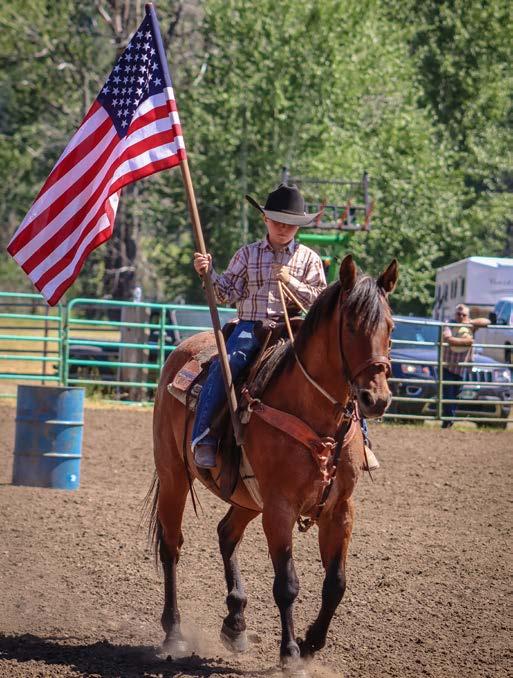
4 minute read
Additional photo contest entries
“O say can you see”
Additional entries from OCA’s Social Media Patriotic Photo Contest
Advertisement


These photos, including this issue’s cover photo, were submitted by Oregon Cattlemen’s Facebook Followers. The winner received $200 to Wilco and was featured on this cover. Follow OCA on Facebook for more contests and giveaways!
Photo Above: Image by Theresa Peterson Martin Underhill Farms Wasco County
Top Left: Photographed by JC Sykes Dalley Sykes (10) & Heyzen Sykes, (8) enjoying a summer ride. Harney County
Bottom Left: Photographed by Jada Follett Waylon McClure carries the flag at the Elgin Stampede Grounds
Top Right: Photographed by K’Lynn Lane Brinlee Tucker rides in the Fourth of July Parade Gilliam County
Bottom Right: Photographed by Marlys Brown “Spotty” taking a break while checking cows. M & L Ranch Linn County


land they own or lawfully occupy (including public land under valid grazing allotments), can haze or scare wolves without a permit if a wolf is in close proximity to livestock, and the actions do not harm or injure the wolf. In addition, on private land, injurious harassment of wolves to minimize conflict is allowed without a permit by producers on private land they own or lawfully occupy when livestock are present. In this situation, there can be no identified circumstance that attracts wolf-livestock conflict. Injurious harassment is hazing wolves, but not pups, in ways that could cause injury but not kill – this includes pursuit. On public land, if wolf-livestock conflict occurs, ODFW can permit livestock producers to injuriously harass wolves on their valid grazing allotment when livestock are present under certain conditions. Any type of injurious harassment needs to be reported to ODFW within 48 hrs.
Caught-In-Act Take: A lethal option, not requiring a permit, available to livestock producers east of Highways 395/78/95 (state managed portion) is to lawfully shoot a wolf caught in the act of biting, wounding, killing or chasing livestock or working dogs on land they own or lawfully occupy (including public land allotments). There can be no bait or other intentional actions to attract wolves, the take needs to be reported to ODFW within 24 hours, and the carcass must not be removed or disturbed. A livestock producer can allow an agent to take a wolf if written authorization procedures are followed (see ODFW website www.odfw.com/wolves). Caught-In-Act Take has occurred three times so far by livestock producers in Oregon.
Other Lethal Options: In the state managed portion of Oregon, ODFW may lethally remove wolves or issue a limited duration permit to a livestock producer to kill wolves on land they own or lawfully occupy. Lethal removal is to minimize further depredation after two confirmed depredations in a nine-month period. The Wolf Plan emphasizes the importance and requires the implementation of non-lethal efforts to reduce wolf-livestock conflict before lethal removal is considered. An evaluation of the amount and effectiveness of appropriate preventative activities may determine whether lethal removal is authorized. Ranchers can increase the chances that lethal removal will be an option by documenting all deterrent activities that they do.
Landowner Information about Wolves in Oregon
The goal of Oregon’s Wolf Conservation and Management Plan is to ensure the conservation of gray wolves as required by Oregon law while protecting the social and economic interests of all Oregonians. That is a challenging goal, but ranchers need to know that ODFW recognizes potential impacts to their operations and the challenges to reduce conflict with wolves.
Be aware of wolf activity in your area: ODFW posts locations of known resident wolf activity on its wolf website (www.odfw.com/wolves). However, wolves do occur in other areas of Oregon and it is important to learn to recognize wolf sign. Also watch for livestock behavior changes (e.g. bunching animals, animals breaking through fences, livestock reacting around working dogs). If you detect changes, take the time to look for wolf sign. Please report any wolf sign or sightings on the online reporting system or to your local ODFW field office. Your local ODFW wildlife biologists are happy to share information they know about recent wolf activity in the area you pasture your livestock.
Livestock Producer Assistance:
Effective proactive measures to reduce wolf-livestock conflict vary by the type of livestock being protected and the size and location of the pasture. Reducing attractants by removing carcasses and bone piles may be the single best action to prevent attracting wolves to areas of livestock in wintering and calving pastures. ODFW, USFWS, and USDA Wildlife Services support producers with technical advice, non-lethal supplies, and assistance with implementation.
If you believe a wolf has killed or injured livestock, take the following steps: Cover any carcass with a tarp to preserve it. If possible, separate an injured calf for the examination. Preserve wolf tracks, hair, or scat at the scene by covering with materials that won’t impact the evidence. Keep dogs away and minimize human traffic. Call your local ODFW office, USDA Wildlife Services, or a county official immediately so an investigation can determine if wolves were involved. West of Hwy’s 395-78-95, USFWS can also be contacted. Please note that to receive compensation under the Oregon Department of Agriculture (ODA) Compensation Program or for ODFW to implement lethal control options, ODFW must make the depredation determination through specific investigation protocol.
Compensation Program: ODA implements Oregon’s Wolf Depredation Compensation and Financial Assistance Grant Program. Participating counties form local committees which then apply for grants to compensate producers for wolf-caused losses and provide funds/supplies for the implementation of preventative measures to reduce conflict. Producers are encouraged to contact their county compensation committee to determine funding and supply availability for their operations. Information is available by contacting your local compensation committee or at ODA website www.oregon.gov/ODA/programs/ ISCP/Pages/WolfDepredation.aspx. •









